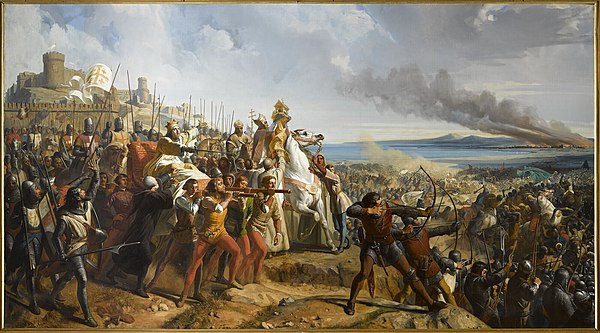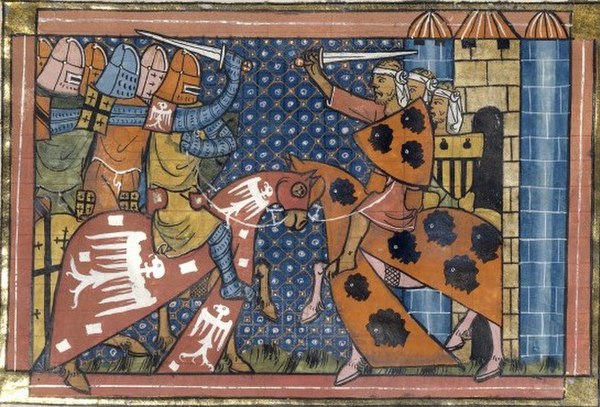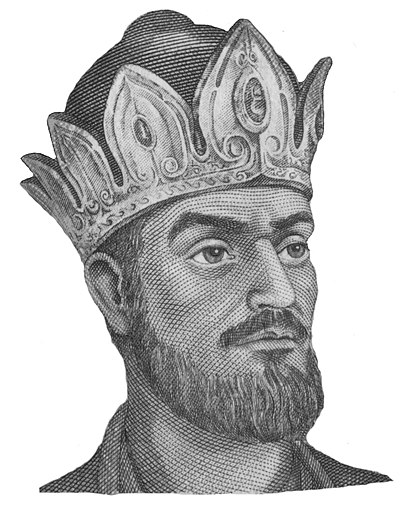
Turcs seldjoukides Chronologie
annexes
personnages
notes de bas de page
les références

Prologue
Jankent, Kazakhstan
Les Seldjoukides se convertissent à l'Islam
Kyzylorda, Kazakhstan
Les Seldjoukides migrent vers la Perse
Mazandaran Province, Iran
Bataille d'inquiétude
Mary, Turkmenistan
Règle seldjoukide du Khorasan
Turkmenistan
Les Seldjoukides rencontrent l'Empire byzantin
Pasinler, Erzurum, Türkiye
Les Seldjoukides conquièrent Bagdad
Baghdad, Iraq
Bataille de Damghan
Iran
Alp Arslan devient Sultan
Damghan, IranArslan a vaincu Qutalmısh pour le trône et a succédé le 27 avril 1064 en tant que sultan de l'empire seldjoukide, devenant ainsi le seul monarque de Perse du fleuve Oxus au Tigre.

Alp Arslan conquiert l'Arménie et la Géorgie
Ani, ArmeniaDans l'espoir de capturer Césarée Mazaca, la capitale de la Cappadoce, Alp Arslan se plaça à la tête de la cavalerie turkmène, traversa l'Euphrate, entra et envahit la ville. Avec Nizam al-Mulk, il marcha ensuite en Arménie et La Géorgie , qu'il conquit en 1064. Après un siège de 25 jours, les Seldjoukides s'emparèrent d'Ani, la capitale de l'Arménie, et massacrèrent sa population.

Lutte byzantine
Cilicia, Turkey
Bataille de Manzikert
Manzikert
Malik Shah devient sultan
Isfahan, Iran
Turkification de l'Anatolie
Anatolia, Türkiye
Bataille de Kerj Abu Dulaf
Hamadan, Hamadan Province, Ira
Les Seldjoukides battent les Qarakhanides
Bukhara, Uzbekistan
Bataille de Partskhissi
Partskhisi, Georgia
Principauté de Danishmends
Sivas, Turkey
Malik Shah I envahit la Géorgie
Georgia
Sultanat seldjoukide de Rum
Asia Minor
Les Turcs seldjoukides prennent Damas
Damascus
Fondation de la Principauté de Smyrne
Smyrna
Les Seldjoukides prennent Antioche et Alep
Antioch, Turkey
Résurgence byzantine en Anatolie
Enez, Edirne, Türkiye
Partage de l'Empire
Isfahan, Iran
Fragmentation de l'empire seldjoukide
Syria
Première croisade
Levant
Siège de Xérigordos
Xerigordos
Bataille d'Antioche
Edessa & Antioch
Bataille de Mersivan
Merzifon, Amasya, Türkiye
Bataille d'Ertsukhi
Tbilisi, Georgia
Bataille de Ghazni
Ghazni, Afghanistan
Bataille de Didgori
Didgori, Georgia
Bataille de Qatwan
Samarkand, Uzbekistan
Siège d'Edesse
Edessa
Deuxième croisade
Levant
Les Seldjoukides perdent encore du terrain
Anatolia, Türkiye
L'empire seldjoukide s'effondre
Anatolia, TurkeyÉpilogue
Antakya, Küçükdalyan, Antakya/HistoryMaps Shop

Heroes of the American Revolution Painting
Explore the rich history of the American Revolution through this captivating painting of the Continental Army. Perfect for history enthusiasts and art collectors, this piece brings to life the bravery and struggles of early American soldiers.
Appendices
APPENDIX 1
Coming of the Seljuk Turks

APPENDIX 2
Seljuk Sultans Family Tree

APPENDIX 3
The Great Age of the Seljuks: A Conversation with Deniz Beyazit

Characters

Chaghri Beg
Seljuk Sultan

Suleiman ibn Qutalmish
Seljuk Sultan of Rûm

Malik-Shah I
Sultan of Great Seljuk

Tutush I
Seljuk Sultan of Damascus

Masʽud I of Ghazni
Sultan of the Ghazvanid Empire

David IV of Georgia
King of Georgia

Kaykhusraw II
Seljuk Sultan of Rûm

Alp Arslan
Sultan of Great Seljuk

Seljuk
Founder of the Seljuk Dynasty

Tamar of Georgia
Queen of Georgia

Kilij Arslan II
Seljuk Sultan of Rûm

Tughril Bey
Turkoman founder

David Soslan
Prince of Georgia

Baiju Noyan
Mongol Commander

Suleiman II
Seljuk Sultan of Rûm

Romanos IV Diogenes
Byzantine Emperor
Footnotes
- Concise Britannica Online Seljuq Dynasty 2007-01-14 at the Wayback Machine article
- Wink, Andre, Al Hind: the Making of the Indo-Islamic World Brill Academic Publishers, 1996, ISBN 90-04-09249-8 p. 9
- Michael Adas, Agricultural and Pastoral Societies in Ancient and Classical History, (Temple University Press, 2001), 99.
- Peacock, Andrew (2015). The Great Seljuk Empire. Edinburgh University Press Ltd. ISBN 978-0-7486-9807-3, p.25
- Bosworth, C.E. The Ghaznavids: 994-1040, Edinburgh University Press, 1963, 242.
- Sicker, Martin (2000). The Islamic World in Ascendancy : From the Arab Conquests to the Siege of Vienna. Praeger. ISBN 9780275968922.
- Metreveli, Samushia, King of Kings Giorgi II, pg. 77-82.
- Battle of Partskhisi, Alexander Mikaberidze, Historical Dictionary of Georgia, (Rowman & Littlefield, 2015), 524.
- Studi bizantini e neoellenici: Compte-rendu, Volume 15, Issue 4, 1980, pg. 194-195
- W. Treadgold. A History of the Byzantine State and Society, p. 617.
- Runciman, Steven (1987). A history of the Crusades, vol. 2: The Kingdom of Jerusalem and the Frankish East, 1100-1187. Cambridge: Cambridge University Press. pp. 23-25. ISBN 052134770X. OCLC 17461930.
- Arjomand, Said Amir (1999). "The Law, Agency, and Policy in Medieval Islamic Society: Development of the Institutions of Learning from the Tenth to the Fifteenth Century". Comparative Studies in Society and History. 41, No. 2 (Apr.) (2): 263–293. doi:10.1017/S001041759900208X. S2CID 144129603.
- Basan, Osman Aziz (2010). The Great Seljuqs: A History. Taylor & Francis.
- Berkey, Jonathan P. (2003). The Formation of Islam: Religion and Society in the Near East, 600–1800. Cambridge University Press.
- Bosworth, C.E. (1968). "The Political and Dynastic History of the Iranian World (A.D. 1000–1217)". In Boyle, J.A. (ed.). The Cambridge History of Iran. Vol. 5: The Saljuq and Mongol Periods. Cambridge University Press.
- Bosworth, C.E., ed. (2010). The History of the Seljuq Turks: The Saljuq-nama of Zahir al-Din Nishpuri. Translated by Luther, Kenneth Allin. Routledge.
- Bulliet, Richard W. (1994). Islam: The View from the Edge. Columbia University Press.
- Canby, Sheila R.; Beyazit, Deniz; Rugiadi, Martina; Peacock, A.C.S. (2016). Court and Cosmos: The Great Age of the Seljuqs. The Metropolitan Museum of Art.
- Frye, R.N. (1975). "The Samanids". In Frye, R.N. (ed.). The Cambridge History of Iran. Vol. 4:The Period from the Arab invasion to the Saljuqs. Cambridge University Press.
- Gardet, Louis (1970). "Religion and Culture". In Holt, P.M.; Lambton, Ann K. S.; Lewis, Bernard (eds.). The Cambridge History of Islam. Vol. 2B. Cambridge University Press. pp. 569–603.
- Herzig, Edmund; Stewart, Sarah (2014). The Age of the Seljuqs: The Idea of Iran Vol.6. I.B. Tauris. ISBN 978-1780769479.
- Hillenbrand, Robert (1994). Islamic Architecture: Form, Function, and Meaning. Columbia University Press.
- Korobeinikov, Dimitri (2015). "The Kings of the East and the West: The Seljuk Dynastic Concept and Titles in the Muslim and Christian sources". In Peacock, A.C.S.; Yildiz, Sara Nur (eds.). The Seljuks of Anatolia. I.B. Tauris.
- Kuru, Ahmet T. (2019). Islam, Authoritarianism, and Underdevelopment: A Global and Historical Underdevelopment. Cambridge University Press.
- Lambton, A.K.S. (1968). "The Internal Structure of the Saljuq Empire". In Boyle, J.A. (ed.). The Cambridge History of Iran. Vol. 5: The Saljuq and Mongol Periods. Cambridge University Press.
- Minorsky, V. (1953). Studies in Caucasian History I. New Light on the Shaddadids of Ganja II. The Shaddadids of Ani III. Prehistory of Saladin. Cambridge University Press.
- Mirbabaev, A.K. (1992). "The Islamic lands and their culture". In Bosworth, Clifford Edmund; Asimov, M. S. (eds.). History of Civilizations of Central Asia. Vol. IV: Part Two: The age of achievement: A.D. 750 to the end of the fifteenth century. Unesco.
- Christie, Niall (2014). Muslims and Crusaders: Christianity's Wars in the Middle East, 1095–1382: From the Islamic Sources. Routledge.
- Peacock, Andrew C. S. (2010). Early Seljūq History: A New Interpretation.
- Peacock, A.C.S.; Yıldız, Sara Nur, eds. (2013). The Seljuks of Anatolia: Court and Society in the Medieval Middle East. I.B.Tauris. ISBN 978-1848858879.
- Peacock, Andrew (2015). The Great Seljuk Empire. Edinburgh University Press Ltd. ISBN 978-0-7486-9807-3.
- Mecit, Songül (2014). The Rum Seljuqs: Evolution of a Dynasty. Routledge. ISBN 978-1134508990.
- Safi, Omid (2006). The Politics of Knowledge in Premodern Islam: Negotiating Ideology and Religious Inquiry (Islamic Civilization and Muslim Networks). University of North Carolina Press.
- El-Azhari, Taef (2021). Queens, Eunuchs and Concubines in Islamic History, 661–1257. Edinburgh University Press. ISBN 978-1474423182.
- Green, Nile (2019). Green, Nile (ed.). The Persianate World: The Frontiers of a Eurasian Lingua Franca. University of California Press.
- Spuler, Bertold (2014). Iran in the Early Islamic Period: Politics, Culture, Administration and Public Life between the Arab and the Seljuk Conquests, 633–1055. Brill. ISBN 978-90-04-28209-4.
- Stokes, Jamie, ed. (2008). Encyclopedia of the Peoples of Africa and the Middle East. New York: Facts On File. ISBN 978-0-8160-7158-6. Archived from the original on 2017-02-14.
- Tor, D.G. (2011). "'Sovereign and Pious': The Religious Life of the Great Seljuq Sultans". In Lange, Christian; Mecit, Songul (eds.). The Seljuqs: Politics, Society, and Culture. Edinburgh University Press. pp. 39–62.
- Tor, Deborah (2012). "The Long Shadow of Pre-Islamic Iranian Rulership: Antagonism or Assimilation?". In Bernheimer, Teresa; Silverstein, Adam J. (eds.). Late Antiquity: Eastern Perspectives. Oxford: Oxbow. pp. 145–163. ISBN 978-0-906094-53-2.
- Van Renterghem, Vanessa (2015). "Baghdad: A View from the Edge on the Seljuk Empire". In Herzig, Edmund; Stewart, Sarah (eds.). The Age of the Seljuqs: The Idea of Iran. Vol. VI. I.B. Tauris.